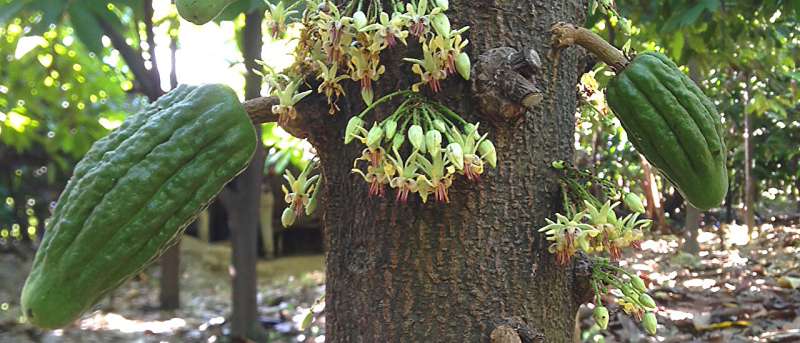Optimizing cacao pollination for higher yields

A research team including Ingolf Steffan-Dewenter's Department of Animal Ecology and Tropical Biology has investigated how the cultivation of cacao can be improved by using the right pollination technique. The success of cacao cultivation depends to a large extent on functioning pollination. If there is a lack of pollinators, for example, this leads to lower yields—and thus to financial problems for farmers.
A study involving the University of Würzburg (JMU) has now investigated how the yield and quality of organic cacao can be increased—through a more efficient plantation design that's taking ecological aspects into account. During field research in Peru, the researchers identified pollination techniques that improved pollination success and produced higher quality fruit.
To do this, the team first compared self-pollination of the flower with cross-pollination. In self-pollination, the stigma is pollinated by pollen from one's own flower (which are genetically identical), whereas in cross-pollination the pollen comes from a flower of another cacao tree. The result: While self-pollination led to only limited success, this value improved three to eight times with cross-pollinated plants. The findings are published in the journal Agriculture, Ecosystems & Environment.
Study provides basis for improved plantation design
"Cacao has a mechanism that seems to prevent self-pollination," explains Dr. Justine Vansynghel, researcher at the Department of Animal Ecology and Tropical Biology (Zoology III). A high genetic difference, that is the lowest possible degree of relationship between pollen donor and pollen recipient, is crucial for pollination success.
"Our research helps farmers in a very concrete way to optimize their plantations for natural cross-pollination in the future," she continues. "We can identify pollinator-recipient combinations that produce high-quality fruit and should therefore be planted spatially close together. This goes hand in hand with better land use, higher yields and thereby a higher income for farmers."
In addition to genetic make-up, the scientists were even able to identify other environmental factors that affect pollination success, such as temperature and relative humidity.
More information: Justine Vansynghel et al, Cross-pollination with native genotypes improves fruit set and yield quality of Peruvian cacao, Agriculture, Ecosystems & Environment (2023).
Provided by Julius-Maximilians-Universität Würzburg



















